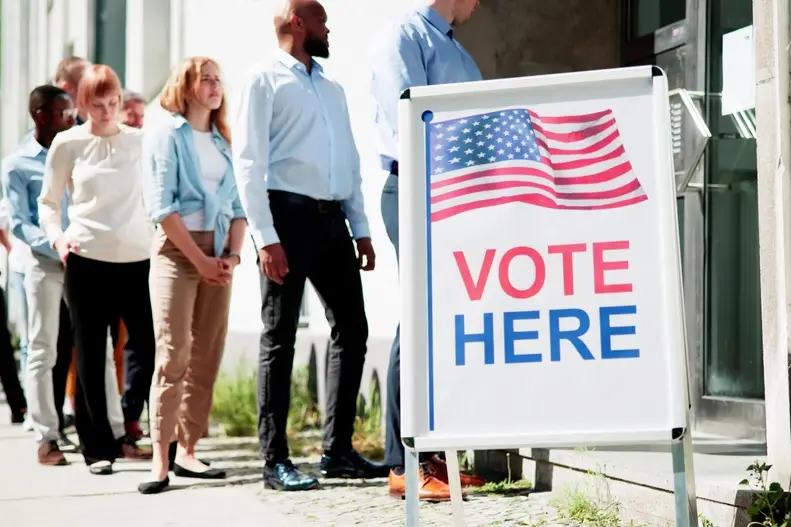As Elon Musk considers launching his own political party and Trump’s big, beautiful spending bill takes effect, the 2026 midterms are set to be explosive.
Political traders are already placing bets on the midterm elections. Thanks to widespread publicity of prediction markets as notable forecasting tools during the 2024 presidential election, the insights of the most successful political traders have become increasingly interesting to a broader audience.
Jesse Richardson, @politicalkiwi on X, is a political prediction market trader and forecaster who recently launched a Substack newsletter, Golden Path.
Prediction News caught up with Richardson at Manifest 2025 to get his thoughts on how to wrap our heads around the 2026 midterm elections, beginning with an observation that has gone unnoticed by many political analysts: Democrats no longer benefit from higher voter turnout. Instead, Republicans do.
Note: This is Part I of a two-part interview series.
Voter turnout benefits have reversed
For starters, it’s important to understand that the midterm electorate is composed differently than the presidential one. Turnout is lower in midterm elections than presidential ones, and the demographics tend to be richer, older, and whiter.
“Historically, this has benefited Republicans, because Republicans [were] the party of rich, older white people,” Richardson said. “However, this is no longer true, and Democrats now consistently do better with the highest-turnout voters. Democrats still struggle with white voters compared to non-white voters, but the gap has narrowed a lot, and they now straightforwardly do better with both more educated and richer voters as well as older voters.”
A Pew Survey analysis of the 2024 electorate found that “voters under the age of 50 made up a larger share of Trump’s coalition in 2024 than in 2016.”
Wealthy and educated Americans have also been gravitating toward the Democratic Party since the 1990s, in part due to issues like climate change and gay marriage, and other issues culturally important to cosmopolitan liberals.
Meanwhile, voters without college degrees and working-class Americans have flocked to the Republican Party. Republican candidates are culturally more similar to working-class voters who feel out of touch with elitist issues like climate change or excessive language policing.
Still, these voters are most likely to be disrupted by laws making it more difficult to vote, which tend to be sponsored by Republicans. For example, Republicans in several states increased penalties for organized in-person voter registration assistance. AP News reported that some voter outreach groups had to “cease operations” or “[reduce] their activities.”
A Pew Survey released in February 2024 found that 93% of liberal Democrats still supported allowing any voter to vote by mail compared to support from just 21% of conservative Republicans. According to Richardson:
“Democrats and Republicans are both kind of stuck in the mindset of…their coalition from 10 years ago, and they haven’t actually realized that things have changed.”
Why doesn’t party registration tell this story?
In speaking about the modern American electorate, Richardson remained close to data about what voters thought instead of relying on proxy variables to forecast the election. He gave the example of voter registration, a metric he considered unreliable:
“You have places in West Virginia where a majority of people are registered Democrats, but 80% of people are Trump voters, and this is just because people don’t update their party registration. So, it is true that Republicans, in the party registration sense, vote more in midterms, but a large number of these older, more educated Republicans who vote in midterms are actually now anti-Trump and are functionally Democrats.”
“Meanwhile, you have a lot of especially younger, poorer and, for example, Hispanic Democrats, registered Democrats, who have now flipped to Trump, and these are people who don’t vote in midterms and turn out more in the presidential election.”
As for younger, poorer voters who may register as Democrats, they vote in greater numbers during the presidential election than the midterms. Many of these voters who only vote in the presidential election flipped to Trump, paving the way for a strong Democratic showing in the midterms and a strong Republican showing in the presidential election.
Did Democrats misread 2022?
In 2022, Republicans expected a “red wave” to overtake the House and Senate in a rebuke to Biden’s handling of the economy and immigration at the Southern border. Democrats had a strong performance instead, holding onto the Senate and losing the House of Representatives by only five seats. Democrats also made gains in state legislatures and governorships even as they suffered key losses in Florida and New York.
It’s easy to conclude that the Democrats mistook their 2022 midterm success as a signal that Biden should run again or that the party should embrace its most progressive policies. However, Richardson thinks a potential (mis)interpretation of the 2022 midterm results may have actually helped Trump in the presidential election two years later.
“I don’t think Democrats particularly ran to the left part in 2024 because they mistook a mandate, but…I think that Republicans, and especially Trump, saw 2022 as a repudiation of a lot of things that they stood for, especially the very pro-life stuff after the Dobbs decision in 2022,” Richardson said. “So, I think that this contributed to Republicans, and especially Trump, running away a bit from the more extreme pro-life positions in 2024 which really helped them avoid losing the election.”
The Republican retreat proved timely and seemed to work. Politico reported that “voters in critical states like Michigan and Pennsylvania ranked abortion — not inflation or crime — as the most important issue in the midterms.” In 2024, abortion was a distant third to democracy and the economy.
Will Democrats and Republicans adjust for 2026 midterms?
Going into 2026, Democrats will have to ask themselves how they can attack Trump most effectively, and mobilize their electorate without inadvertently aiding Republican candidates. Meanwhile, Republicans must shrug off the baggage of the big, beautiful bill, which cuts social programs and increases the deficit.
But even if Democrats perform well, it shouldn’t be taken as a signal that the party has the country’s confidence. Democrats will still have to earn it in 2028, regardless of their midterm performance.

























